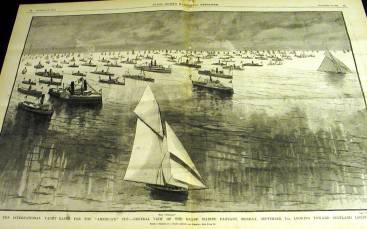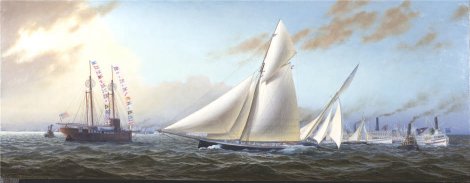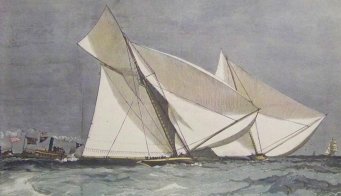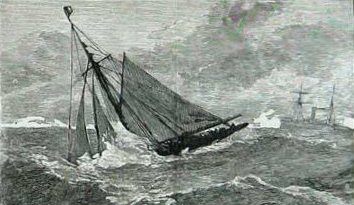Yves GARY Hits: 4965
Category: 1885 : CHALLENGE N°5
 Several postponements
Several postponementsSeptember 7th opened with a thick fog hanging over New York Bay, and through this the racers and a big excursion fleet, loaded to the guards with a patriotic and enthusiastic crowd of sightseers, felt their way down to the Scotland lightship off the Hook.
It lightened a little when they arrived there, but there was no wind, and after hanging around for some hours the starting signal was given at 1:35. There was not enough breeze to get the yachts over the course, and the race was finally postponed until the next day.
 The yachts were on hand at the lightship again the following morning, and found a merry breeze ruffling the surface, giving every indication of excellent racing weather. The preparatory signal was given at 11:32 a. m. and both boats edged up near the line to be in a good position for the starting whistle. As they came together, moving fast, Puritan, on the port tack, tried to cross Genesta's bows, her skipper miscalculating the distance or trying to bluff the English captain, who had the right of way, into going about. The Britishers called the bluff, however, and seeing that he could not clear the Genesta the Puritan's helmsman luffed across the Genesta's bow, the latter's bowsprit going through the Puritan's mainsail, and being snapped off short at the stem by the leach rope. Here was a pretty mess just at the start of an international race, and one that might lead to all sorts of trouble and bad feeling. But Sir Richard Sutton, the young owner of the Genesta, proved himself equal to the occasion.
The yachts were on hand at the lightship again the following morning, and found a merry breeze ruffling the surface, giving every indication of excellent racing weather. The preparatory signal was given at 11:32 a. m. and both boats edged up near the line to be in a good position for the starting whistle. As they came together, moving fast, Puritan, on the port tack, tried to cross Genesta's bows, her skipper miscalculating the distance or trying to bluff the English captain, who had the right of way, into going about. The Britishers called the bluff, however, and seeing that he could not clear the Genesta the Puritan's helmsman luffed across the Genesta's bow, the latter's bowsprit going through the Puritan's mainsail, and being snapped off short at the stem by the leach rope. Here was a pretty mess just at the start of an international race, and one that might lead to all sorts of trouble and bad feeling. But Sir Richard Sutton, the young owner of the Genesta, proved himself equal to the occasion.
The committee boat went alongside the Genesta to find out the extent of her damage, and hailing, told those on board that Puritan had been disqualified, as she was clearly at fault, and that if the Genesta sailed over the course and finished inside the seven-hour time limit, the race was hers. Mr. Roosevelt Schuyler, the American representative on board, was just asking the committee if they would give them time to rig a new bowsprit with the spinnaker boom, when Sir Richard Sutton cut in with:  “We are very much obliged, but we don't want it that way. We came over for a race, not a sailover.”
“We are very much obliged, but we don't want it that way. We came over for a race, not a sailover.”
This sportsmanlike spirit pleased the committee and won the owner of the Genesta great popularity throughout the country. He could have sailed the course and taken the race without question, Puritan being wholly in the wrong, but he preferred otherwise.
Time was given both boats to repair damages, and September 11th was the next time they came together to try to decide which was the speedier, the start again being off the Scotland light-vessel. The course was twenty miles to windward and return, the wind light easterly, though there was considerable bobble of sea which seemed to bother Puritan a little. After sending them away at 11:35 the wind gradually became flatter and flatter, and it was over six hours before Puritan rounded the outer mark. It was then seen that the yachts could not finish in the seven-hour time limit and the race was called off, with Genesta about a mile astern.
 These postponements were getting monotonous; but on the next race day, September 14th, there was a fair southwest breeze blowing and a race was finally sailed. This time the course was the " inside " one, starting off Owl's Head, on the Bay Ridge shore, and going out to Sandy Hook lightship and back, a distance of thirty-eight nautical miles.
These postponements were getting monotonous; but on the next race day, September 14th, there was a fair southwest breeze blowing and a race was finally sailed. This time the course was the " inside " one, starting off Owl's Head, on the Bay Ridge shore, and going out to Sandy Hook lightship and back, a distance of thirty-eight nautical miles.
The starting signal from the judges' boat, the tug Luckenback went at 10:30 and it found the Genesta well to leeward of the line, where she had been set by the strong flood tide. Puritan was in a better  position, crossed first, and the two boats started to beat down the bay, through the Narrows, followed by the ever-present fleet of yachts and excursion boats. Genesta was bothered somewhat on one tack by an incoming bark, and when they passed out by Fort Wadsworth the American boat had a lead of about seven minutes.
position, crossed first, and the two boats started to beat down the bay, through the Narrows, followed by the ever-present fleet of yachts and excursion boats. Genesta was bothered somewhat on one tack by an incoming bark, and when they passed out by Fort Wadsworth the American boat had a lead of about seven minutes.
In the lower bay the wind was uncertain, sometimes coming in good puffs and again dying away to faint airs, and in it the boats worked down to the South West Spit, Puritan having a lead of three minutes at that point. Then, with sheets eased off for the reach to the lightship they traveled fast, with scuppers just awash. Off the point of the Hook the Genesta was crowded by the excursion fleet, which got too near in the anxiety of the captains to give their passengers a good view, and the wash undoubtedly retarded her somewhat, to the great and justified annoyance of her crew, Puritan rounded the lightship at 2:14:54 p. m., Genesta turning 4 minutes and 22 seconds behind her. It was a close reach back to the Hook, with the wind hauling a trifle, so that a short hitch had to be taken to fetch the buoy, and then a broad reach, which Genesta made into a spinnaker run, back to the finish line just outside the Narrows. The wind was lightening all the time and Genesta kept dropping behind, so that she was about a mile astern when Puritan crossed at 4 :38 :05 p. m. in a spiritless and disappointing finish. Puritan allowed Genesta 28 seconds time over the 38-mile course, and the official figures were as follows:

A day intervened before the next race was sailed, but the 16th found both boats at the line established off the Scotland lightship, ready for the decisive battle of the series. There was a fresh autumn nor’wester blowing, flecking the tops of the tumbling seas offshore, and the course was set for a twenty-mile run down wind and a beat back, with every promise of the best race of the series, which the following five hours more than fulfilled.
 Mindful of his bad start in the previous race, Captain Carter, of the Genesta, kept his vessel near the line, so that she got the jump on Puritan and crossed just sixteen seconds after the whistle and forty-five seconds ahead of the American sloop. Both boats broke out immense spinnakers, but Puritan was not close enough to take Genesta’s wind, and the narrow cutter slipped through the water so fast that the hopes of the patriotic abroad the excursion fleet waned as it became apparent that the Yankee sloop had met her match down the wind. Both boats were traveling at a ten-knot clip, but as they neared the outer mark the wind freshened considerably and they took in club topsails for the strenuous beat back. Genesta doused her spinnaker smartly and hauled sheets aft as she rounded the mark, where it was seen that she was fully an eighth of a mile ahead.
Mindful of his bad start in the previous race, Captain Carter, of the Genesta, kept his vessel near the line, so that she got the jump on Puritan and crossed just sixteen seconds after the whistle and forty-five seconds ahead of the American sloop. Both boats broke out immense spinnakers, but Puritan was not close enough to take Genesta’s wind, and the narrow cutter slipped through the water so fast that the hopes of the patriotic abroad the excursion fleet waned as it became apparent that the Yankee sloop had met her match down the wind. Both boats were traveling at a ten-knot clip, but as they neared the outer mark the wind freshened considerably and they took in club topsails for the strenuous beat back. Genesta doused her spinnaker smartly and hauled sheets aft as she rounded the mark, where it was seen that she was fully an eighth of a mile ahead.
Once hauled on the wind, both boats felt the true force of the nor' wester, which was now coming in vicious puffs, while the sea was making up fast and hard. Genesta set a gaff topsail, which shook and slatted at a great rate, but Puritan, seeing that it would be too fresh to carry that sail, housed her topmast, the crew doing the job in seamanlike fashion. They made a leg in under the Long Island shore, where somewhat smoother water was found, and all the time Puritan kept eating out to weather of the cutter, whose topsail, instead of helping her, was shaking so as to hold her back.  It was the first time most of the fleet had seen a cutter in a real breeze and they were astonished at the way Genesta lay over in the puffs, which were now of full thirty-mile strength.
It was the first time most of the fleet had seen a cutter in a real breeze and they were astonished at the way Genesta lay over in the puffs, which were now of full thirty-mile strength.
About three o'clock the boats were abeam of each other off Long Beach, but with Puritan some three-fourths of a mile to weather. Then the wind shifted toward the north so that they could lay the lightship, and Puritan wiped off on the other tack and went banging down toward the Jersey coast, followed by the cutter, both having all they could stagger under. It is the consensus of most yachtsmen that Genesta threw away her chances in the race by lugging her topsail, which was not drawing, instead of clewing it up and housing her topmast, as Puritan had done. Why Carter, who otherwise showed excellent judgment, hung on to it, is not known.
As they neared the Scotland lightship it was seen that the finish would be very close, but Puritan, being to windward and having a little to spare, started sheets and fairly tore down to the line, leaving a wake like an ocean liner, and crossed a little over two minutes ahead of Genesta, this time being reduced by the latter's allowance to 1 minute 38 seconds, as the accompanying table shows:

It was a great race, the most stirring and the closest contest for the Cup up to that time, and fortunate were those who had a chance to follow the racers over the course that blustery autumn day and see them fight it out. As Genesta crossed in Puritan's wake, defeated but not disheartened, she luffed up alongside the winner and her crew gave three generous British cheers for the winner, which were returned as heartily with three Yankee ones from Captain Aubrey Crocker of the Puritan and his crew.
And so ended the most satisfactory race for the Cup that had yet been seen. Genesta's generous owner, Sir Richard Sutton, stayed in this country some three weeks longer, and with unbounded faith in his yacht tried to arrange another match with Puritan. Mr. Forbes, the latter's managing owner, would not race, however, believing that the Puritan had fulfilled her mission in successfully defending the Cup.
Genesta did not go home empty-handed, however, as she won the Bennett and Douglas prizes in races arranged the following weeks, and also the Brenton Reef and Cape May Challenge cups in two long ocean races against the schooner Dauntless. On October 9th she sailed for home under jury rig, making a fast passage, considering the hard head winds she encountered, of 19 days 10 hours to Gosport, England. She proved herself a sturdy, able sea boat, as the following extract from a letter written to a friend by Captain Saunders, her navigator, testifies:
 The Genesta is a wonder. I have never seen her equal as a sea boat. The voyage was a continued series of surprises to me in the way of her marvelous performance under adverse circumstances. We had heavy, strong, and baffling contrary winds nearly all the way over, and heavy seas, and it was amazing to see that little devil get through the water. She traveled 3300 miles in 19 days 10 hours, an average of about seven knots, against heavy seas all the way over.
The Genesta is a wonder. I have never seen her equal as a sea boat. The voyage was a continued series of surprises to me in the way of her marvelous performance under adverse circumstances. We had heavy, strong, and baffling contrary winds nearly all the way over, and heavy seas, and it was amazing to see that little devil get through the water. She traveled 3300 miles in 19 days 10 hours, an average of about seven knots, against heavy seas all the way over.
The entire passage was made under reefed sails, with the exception of two or three brief intervals only. The boat's behavior throughout was beautiful. It couldn't have been better, and every day developed some new good quality in her.
As for the Puritan, the embodiment of new ideas in yacht design that had kept the Americas Cup in this country, she was sold at auction on September 23d, to J. Malcolm Forbes, for only $13,500. She remained his property for many years and was sailed under both sloop and schooner rig until her owner had no further use for her. Less than ten years ago she was sold to some Portuguese of the Cape Verde Islands, and by them was used as a freight and passenger packet between New Bedford, Mass., and her new owners' homes, making, up to quite recent times, two trips a year across the Western ocean in that honorable, if less glorious, trade.
